Analysis of Surface Runoff and Ponding Infiltration Patterns Induced by Underground Block Caving Mining—A Case Study
Abstract
1. Introduction
2. Calculation Method of Rainfall Infiltration Based on Infiltration Zone Division
2.1. Fundamental Principles
2.2. Improvement Methods
3. Surface Deformation Prediction and Infiltration Zone Division Based on Numerical Simulation
3.1. Engineering Background
3.2. Establishment of Three-Dimensional Refined Model
3.3. Range of Surface Movement Induced by Mining and Division of Infiltration Zones
4. Analysis of Surface Runoff-Ponding Infiltration Patterns Induced by Mining Activities
4.1. Simulation of Surface Runoff in Mining Areas Based on HEC-RAS
4.2. Estimation of Rainfall Infiltration in Mining Area Under Rainstorm Condition
4.3. Result Analysis
4.4. Prevention and Control Measures
5. Conclusions and Discussion
5.1. Conclusions
- (1)
- A rainfall infiltration calculation method based on precise delineation of surface catchment infiltration zones was proposed. By integrating field investigations, numerical simulations, and HEC-RAS catchment modeling, the caved zones and water-conducting fracture zones under different mining stages were identified. Different rainfall infiltration coefficients were applied to various infiltration zones, leading to the derivation of a calculation formula for rainfall infiltration volume in surface subsidence areas.
- (2)
- A refined 3D mine model was established using 18 exploration profiles to accurately reconstruct the complex geological environment of Dahongshan Iron Mine. Detailed stope models were created according to mining schedules, providing a foundation for simulating realistic mining-induced surface deformation. A high-precision DEM model of Shilu Iron Mine’s surface was developed using UAV oblique photography data, enabling surface catchment simulation under storm conditions and obtaining water accumulation patterns in mining-induced subsidence zones.
- (3)
- Underground mining reshapes the spatial distribution and infiltration mechanisms through surface deformation. With expanding the mining scope, in Working Condition 2, the infiltration area increased by 10% compared to Condition 1, with over 70% being newly formed caved zones; in Working Condition 3, the infiltration area expanded by 65% versus Condition 1, with newly formed caved zones accounting for over 50%. The peripheral expansion of caved zones and water-conducting fractures doubled the stormwater infiltration volume in Condition 2 and increased it by 2.4 times in Condition 3 compared to Condition 1. This nonlinear growth stems from significantly enhanced overall infiltration capacity due to expanded high-permeability caved zones, which serve as preferential pathways for rapid rainfall percolation and constitute the core mechanism controlling infiltration volume increases.
5.2. Discussion
- (1)
- The applicability of the model is constrained by specific geological conditions. When applied to other mining sites, parameter adjustments and validation must be conducted based on their unique geological characteristics. Rock mechanical parameters were determined through a combination of field tests and numerical inversion. However, due to limitations in exploration data density, spatial variability in localized regions may not be fully characterized. While the Mohr–Coulomb criterion effectively captures shear failure in rock masses, it does not account for strength degradation under cyclic loading. Future improvements could incorporate damage mechanics models to address this limitation.
- (2)
- Given that the waste backfill material in this study primarily consists of coarse-grained particles with large pore sizes, capillary effects exhibit a limited influence, and the difference between saturated and unsaturated permeability coefficients is negligible. Consequently, capillary effects were disregarded. However, for materials containing clay layers or fine-grained tailings, capillary action significantly impacts seepage behavior and must be accounted for using unsaturated flow models such as the Van Genuchten model. Future research should conduct comparative analyses of seepage characteristics across different backfill materials to refine mining seepage theory and develop more universal modeling approaches for varying geological conditions.
- (3)
- Poroelastic theory and fluid–solid coupling analysis hold substantial value for mechanistic studies. However, for large-scale models, fully coupled poroelastic analysis faces practical challenges, including high computational resource demands and insufficient permeability field data. Future work could focus on small-scale poroelastic simulations in critical zones, combined with parameter inversion using surface monitoring data, to enhance understanding of localized deformation mechanisms. While the current simplified approach provides effective support for engineering decision-making, refined poroelastic modeling represents a promising direction for subsequent research to improve prediction accuracy and model applicability.
Author Contributions
Funding
Institutional Review Board Statement
Informed Consent Statement
Data Availability Statement
Acknowledgments
Conflicts of Interest
References
- Ak, H.; Iphar, M.; Yavuz, M.; Konuk, A. Evaluation of Ground Vibration Effect of Blasting Operations in a Magnesite Mine. Soil Dyn. Earthq. Eng. 2009, 29, 669–676. [Google Scholar] [CrossRef]
- Whittle, D.; Brazil, M.; Grossman, P.A.; Rubinstein, J.H.; Thomas, D.A. Combined Optimisation of an Open-Pit Mine Outline and the Transition Depth to Underground Mining. Eur. J. Oper. Res. 2018, 268, 624–634. [Google Scholar] [CrossRef]
- Christmann, P. Mineral Resource Governance in the 21st Century and a Sustainable European Union. Miner. Econ. 2021, 34, 187–208. [Google Scholar] [CrossRef]
- Lu, W.B.; Yang, J.H.; Yan, P.; Chen, M.; Zhou, C.B.; Luo, Y.; Jin, L. Dynamic Response of Rock Mass Induced by the Transient Release of In-Situ Stress. Int. J. Rock Mech. Min. Sci. 2012, 53, 129–141. [Google Scholar] [CrossRef]
- Wu, L.Z.; Zhang, L.M.; Zhou, Y.; Li, B.E. Analysis of Multi-Phase Coupled Seepage and Stability in Anisotropic Slopes under Rainfall Condition. Environ. Earth Sci. 2017, 76, 469. [Google Scholar] [CrossRef]
- Zhang, J.; Feng, X.; Wu, A.; Chen, H.Y.; Li, Z.R.; Wang, S.Y.; Sun, W.; Chen, C. Critical Early Warning of Underground Debris Flows in Mines Based on Rainfall–Collapse Characteristics. Nat. Hazards 2025, 121, 423–445. [Google Scholar] [CrossRef]
- Lan, X.; Wang, Y.; Wang, X.; Geng, J. Study on the Destabilisation Pattern and Volumetric Water Content Evolution Characteristics of Underground Mining Rock Formations Under Heavy Rainfall Conditions. Water 2025, 17, 136. [Google Scholar] [CrossRef]
- Li, X.H.; Li, Q.H.; Wang, Y.M.; Liu, W.; Hou, D.; Zheng, W.B.; Zhang, X. Experimental Study on Instability Mechanism and Critical Intensity of Rainfall of High-Steep Rock Slopes Under Unsaturated Conditions. Int. J. Min. Sci. Technol. 2023, 33, 1243–1260. [Google Scholar] [CrossRef]
- Li, Q.H.; Song, D.Q.; Yuan, C.M.; Nie, W. An Image Recognition Method for the Deformation Area of Open-Pit Rock Slopes Under Variable Rainfall. Measurement 2022, 188, 187–208. [Google Scholar] [CrossRef]
- Wang, C.; Min, H.; Zhu, T.; Wang, H.; Qin, W.N.; Zhang, G. Failure Mechanism and Stability Analysis of the Landslide: A Case Study for Open Pit Iron Mine in Xichang, Sichuan, China. Nat. Hazards 2023, 116, 663–691. [Google Scholar] [CrossRef]
- Nian, G.; Chen, Z.; Zhu, T.; Zhang, H.F.; Zhou, Z.H. Experimental Study on the Failure of Fractured Rock Slopes with Anti-Dip and Strong Weathering Characteristics Under Rainfall Conditions. Landslides 2024, 21, 165–182. [Google Scholar] [CrossRef]
- Xiang, P.; Ji, H.G.; Geng, J.M.; Zhao, Y.W. Characteristics and Mechanical Mechanism of In Situ Unloading Damage and Core Discing in Deep Rock Mass of Metal Mine. Shock Vib. 2022, 2022, 5147868. [Google Scholar] [CrossRef]
- Li, Q.; Wang, Y.; Li, X.; Gong, B. Rainfall–Mining Coupling Effects on Slope Failure Mechanism and Evolution Process: A Case Study of Open-Pit to Underground Mining. Water 2024, 16, 740. [Google Scholar] [CrossRef]
- Demand, D.; Blume, T.; Weiler, M. Spatio-temporal Relevance and Controls of Preferential Flow at the Landscape Scale. Hydrol. Earth Syst. Sci. 2019, 23, 4869–4889. [Google Scholar] [CrossRef]
- Zhan, T.L.T.; Qiu, Q.W.; Xu, W.J. Analytical Solution for Infiltration and Deep Percolation of Rainwater into a Monolithic Cover Subjected to Different Patterns of Rainfall. Comput. Geotech. 2016, 77, 1–10. [Google Scholar] [CrossRef]
- Feng, S.; Huang, R.H.; Zhan, L.T.; Liu, H.W. Semi-Analytical Solution of Pore-Water Pressure in Unsaturated Ground and Infinite Slope Considering Highly Nonlinear Soil Hydraulic Properties. Comput. Geotech. 2023, 164, 105795. [Google Scholar] [CrossRef]
- Wu, L.Z.; He, B.; Peng, J.B. Analysis of Rainfall-Caused Seepage into Underlying Bedrock Slope Based on Seepage Deformation Coupling. Int. J. Geomech. 2024, 24, 04024043. [Google Scholar] [CrossRef]
- Tracy, F.T.; Vahedifard, F. Analytical Solution for Coupled Hydro-Mechanical Modeling of Infiltration in Unsaturated Soils. J. Hydrol. 2022, 612, 128198. [Google Scholar] [CrossRef]
- Su, Z.; Chen, G.; Meng, Y. Study on Seepage Characteristics and Stability of Core Dam Under the Combined Action of the Variation of Reservoir Water Level and Rainfall. Geotech. Geol. Eng. 2021, 39, 193–211. [Google Scholar] [CrossRef]
- Hou, D.; Zhou, Y.; Zheng, X. Seepage and Stability Analysis of Fissured Expansive Soil Slope Under Rainfall. Indian Geotech. J. 2023, 53, 180–195. [Google Scholar] [CrossRef]
- Paronuzzi, P.; Fedrigo, D.; Bolla, A. Rainfall Infiltration through Stratified Colluvial Deposits: Analytical Approach vs. Numerical Modelling. Geosciences 2024, 14, 53. [Google Scholar] [CrossRef]
- Hou, X.P.; Fan, H.H. Study on Rainfall Infiltration Characteristics of Unsaturated Fractured Soil Based on COMSOL Multiphysics. Rock Soil Mech. 2022, 43, 563–572. [Google Scholar]
- Zhong, J.Z.; Li, D.; Jiang, K. Assessment of Urban Underground Spaces Inundation During Extreme Rainfall Events. Water Sci. Technol. 2024, 89, 2851–2866. [Google Scholar] [CrossRef]
- Aguilar-López, J.P.; Bogaard, T.; Gerke, H.H. Dual-Permeability Model Improvements for Representation of Preferential Flow in Fractured Clays. Water Resour. Res. 2020, 56, 8. [Google Scholar] [CrossRef]
- Ma, L.; Huang, C.; Liu, Z.S.; Morin, K.A.; Dy, E.; Tufa, K.; Fisher, E.; Zhou, J.; Aziz, M.; Meints, C. A Full-Scale Case Study on the Leaching Process of Acid Rock Drainage in Waste Rock Piles and the Net Infiltration Through Cover Systems. Water Air Soil Pollut. 2020, 231, 305. [Google Scholar] [CrossRef]
- Parsasadr, H.; Mustafa, S.; Golian, M.; Bense, V. Development of a Finite Element Groundwater Flow Model to Test Drainage Management Strategies for the Expansion of the Dareh-Zar Open Pit Mine, Iran. Hydrogeol. J. 2024, 32, 1145–1165. [Google Scholar] [CrossRef]
- Liu, B.; Liu, G.; Sha, J.; Sun, J.; Zhao, X.; Ren, S.; Liu, R.; Li, S. Numerical Simulation of the Interaction Between Mine Water Drainage and Recharge: A Case Study of Wutongzhuang Coal Mine in Heibei Province, China. Ecol. Indic. 2024, 158, 111568. [Google Scholar] [CrossRef]
- Liu, Z.; Rong, L.; Wei, W. Impacts of Land Use/Cover Change on Water Balance Using the SWAT Model in a Typical Loess Hilly Watershed of China. Geogr. Sustain. 2023, 4, 19–28. [Google Scholar] [CrossRef]
- Poozan, A.; Western, A.W.; Burns, M.J.; Arora, M. Modelling the Interaction Between Vegetation and Infiltrated Stormwater. J. Hydrol. 2022, 607, 127527. [Google Scholar] [CrossRef]
- AL-Hussein, A.A.M.; Khan, S.; Ncibi, K.; Hamdi, N.; Hamed, Y. Flood Analysis Using HEC-RAS and HEC-HMS: A Case Study of Khazir River (Middle East—Northern Iraq). Water 2022, 14, 3779. [Google Scholar] [CrossRef]
- Guven, D.S.; Yenigun, K.; Isinkaralar, O.; Isinkaralar, K. Modeling Flood Hazard Impacts Using GIS-Based HEC-RAS Technique Towards Climate Risk in Şanlıurfa, Türkiye. Nat. Hazards 2025, 121, 3657–3675. [Google Scholar] [CrossRef]
- Zuo, J.; Wang, J.; Jiang, Y. Macro/Meso Failure Behavior of Surrounding Rock in Deep Roadway and Its Control Technology. Int. J. Coal Sci. Technol. 2019, 6, 301–319. [Google Scholar] [CrossRef]
- Sun, M.; Du, Y.; Liu, Q.; Feng, G.; Peng, X.; Liao, C. Understanding the Spatial-Temporal Characteristics of Land Subsidence in Shenzhen Under Rapid Urbanization Based on MT-InSAR. IEEE J. Sel. Top. Appl. Earth Obs. Remote Sens. 2023, 16, 4153–4166. [Google Scholar] [CrossRef]
- Liu, Y.; Yang, T.; Zhao, Y.; Ma, K.; Hou, X.; Zhao, Q.; Li, J. Characteristics of Strata Movement and Method for Runoff Disaster Management for Shallow Multiseam Mining in Gully Regions: A Case Study. Int. J. Rock Mech. Min. Sci. 2023, 172, 105608. [Google Scholar] [CrossRef]
- Pu, C.; Xu, Q.; Zhao, K.; Jiang, Y.; Hao, L.; Liu, J.; Chen, W.; Kou, P. Characterizing the Topographic Changes and Land Subsidence Associated with the Mountain Excavation and City Construction on the Chinese Loess Plateau. Remote Sens. 2021, 13, 1556. [Google Scholar] [CrossRef]
- He, Z.; Yang, Z.; Wu, X.; Zhang, T.; Song, M.; Liu, M. Triggering of Land Subsidence in and Surrounding the Hangjiahu Plain Based on Interferometric Synthetic Aperture Radar Monitoring. Remote Sens. 2024, 16, 1864. [Google Scholar] [CrossRef]
- Li, J.D.; Yang, T.H.; Liu, F.Y.; Zhao, Y.; Liu, H.L.; Deng, W.X.; Gao, Y.; Li, H.B. Modeling Spatial Variability of Mechanical Parameters of Layered Rock Masses and Its Application in Slope Optimization at the Open-Pit Mine. Int. J. Rock Mech. Min. Sci. 2024, 181, 105859. [Google Scholar] [CrossRef]
- Li, J.; Gao, Y.; Yang, T.; Zhang, P.H.; Deng, W.X.; Liu, F.Y. Effect of Water on the Rock Strength and Creep Behavior of Green Mudstone. Geomech. Geophys. Geo-Energ. Geo-Resour. 2023, 9, 101. [Google Scholar] [CrossRef]
- Li, J.D.; Gao, Y.; Yang, T.H.; Zhang, P.H.; Zhao, Y.; Deng, W.X.; Liu, H.L.; Liu, F.Y. Integrated Simulation and Monitoring to Analyze Failure Mechanism of the Anti-Dip Layered Slope with Soft and Hard Rock Interbedding. Int. J. Min. Sci. Technol. 2023, 33, 1147–1164. [Google Scholar] [CrossRef]
- GB 50830-2013; Code for Design of Metal Mine. China Planning Press: Beijing, China, 2013.
- GB 50014-2006; Code for Design of Outdoor Wastewater Engineering. China Planning Press: Beijing, China, 2006.

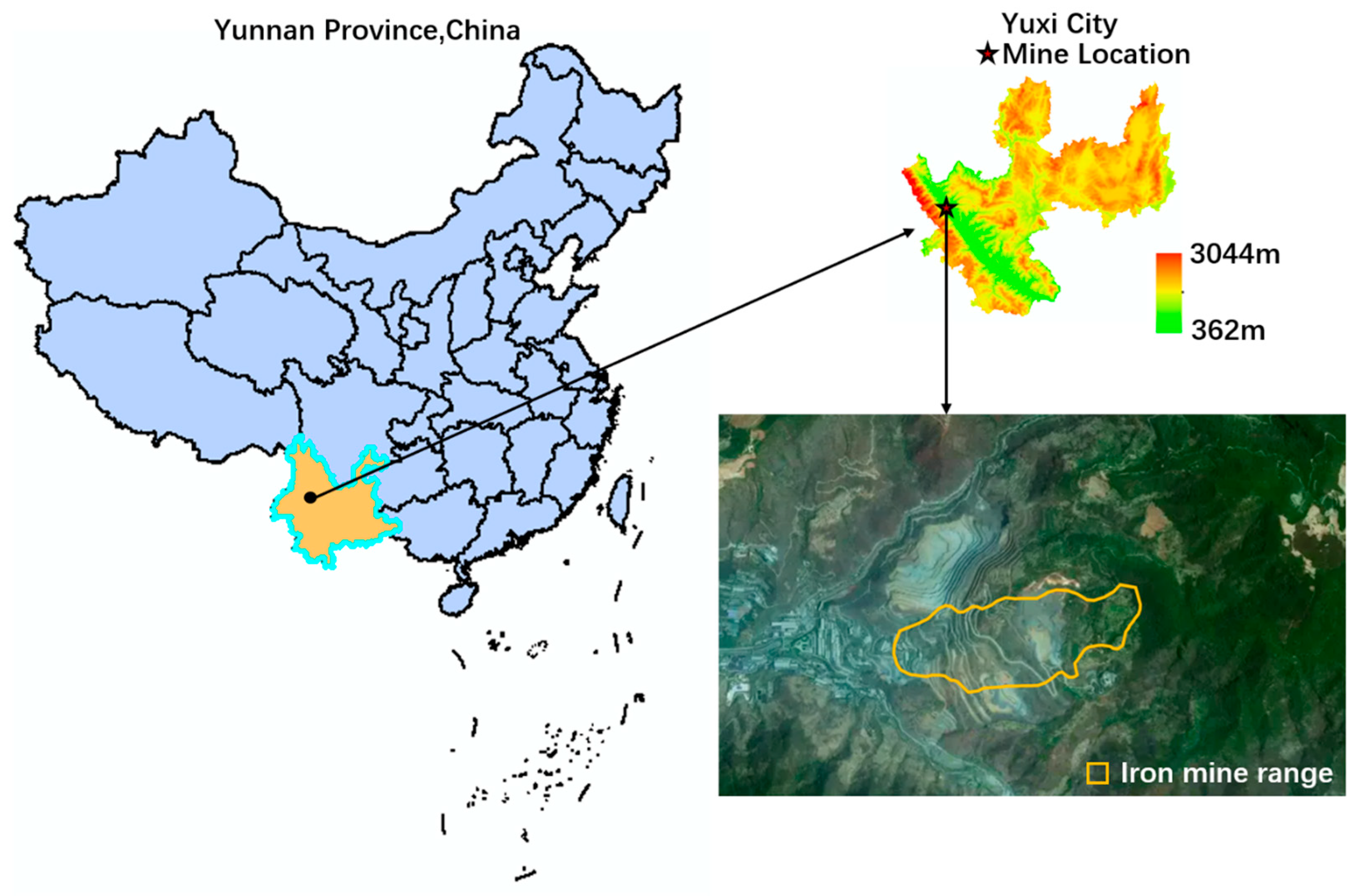
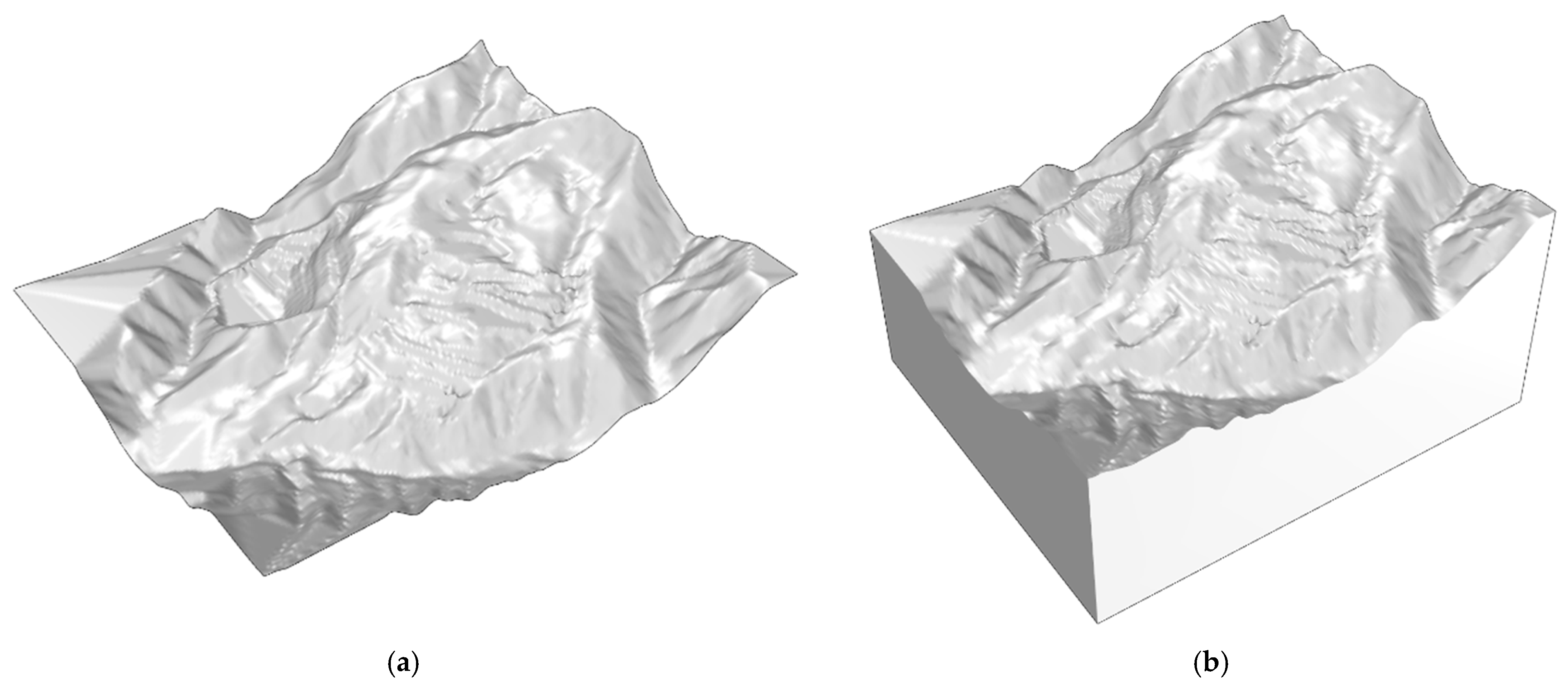
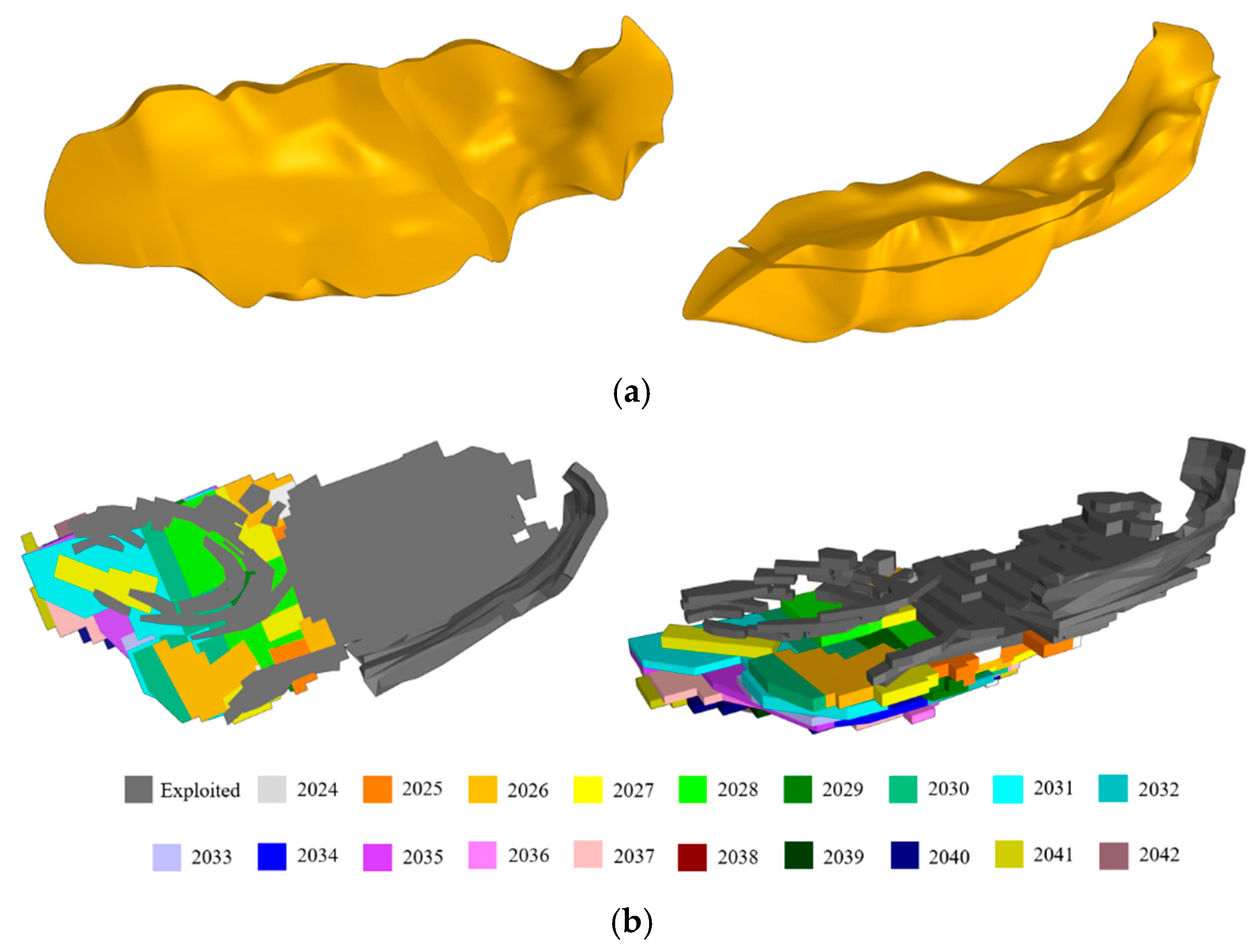
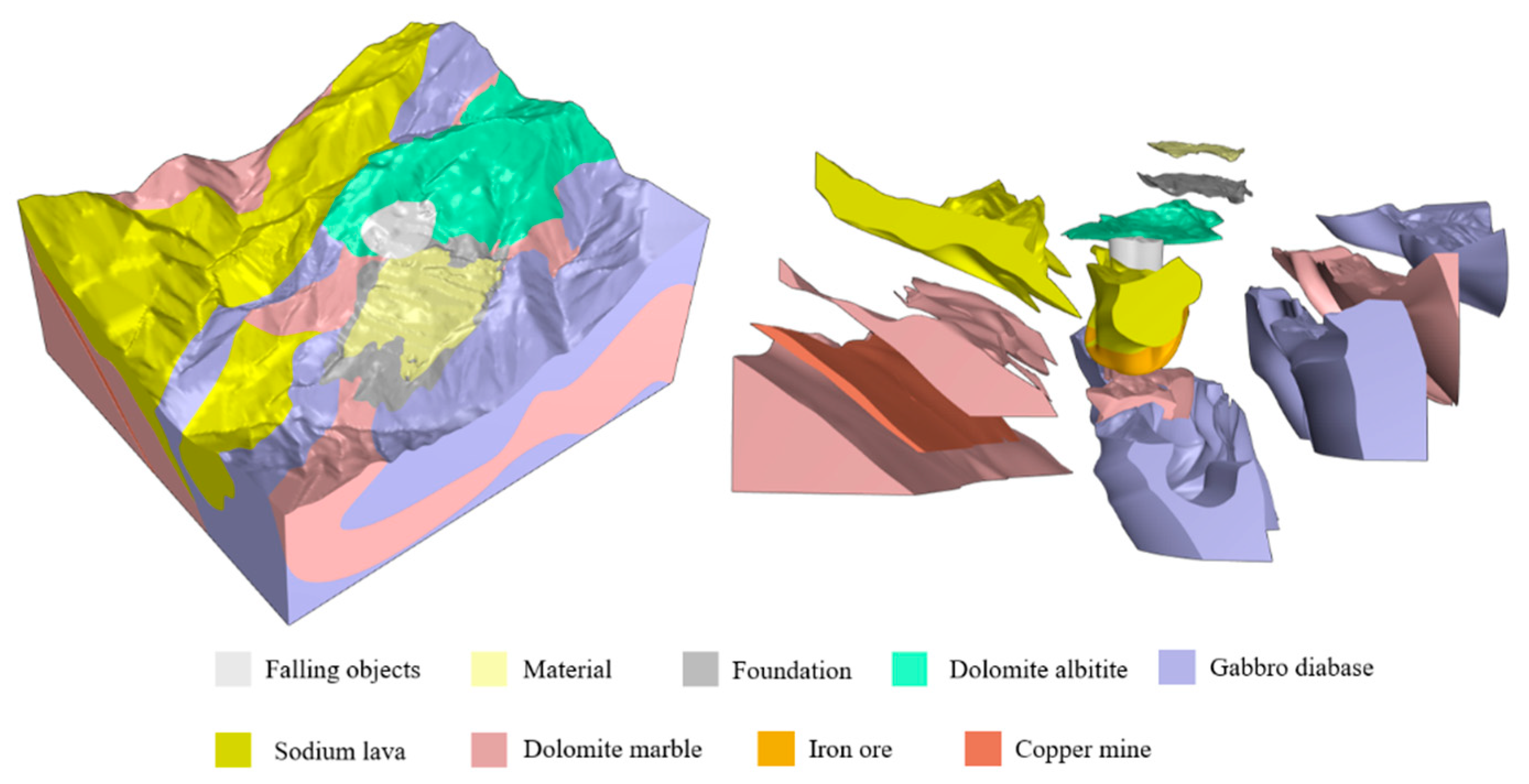




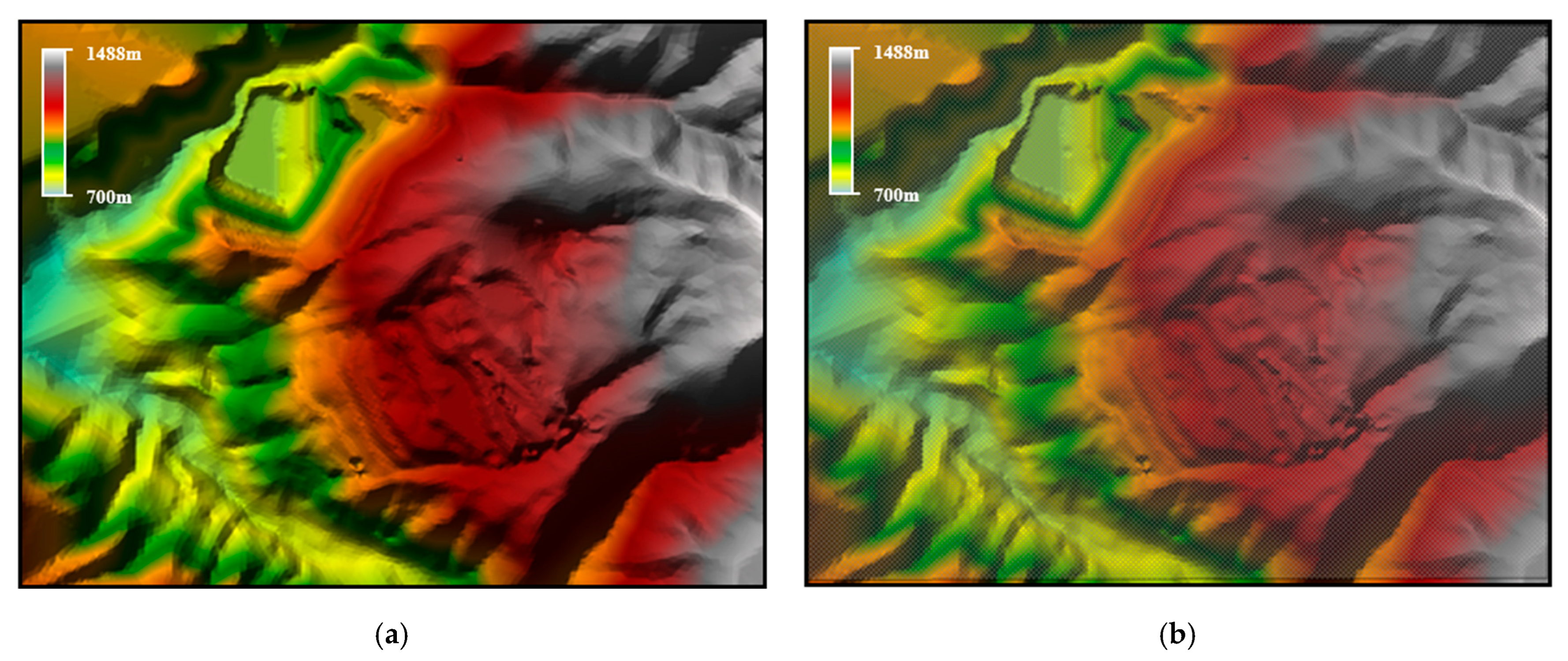
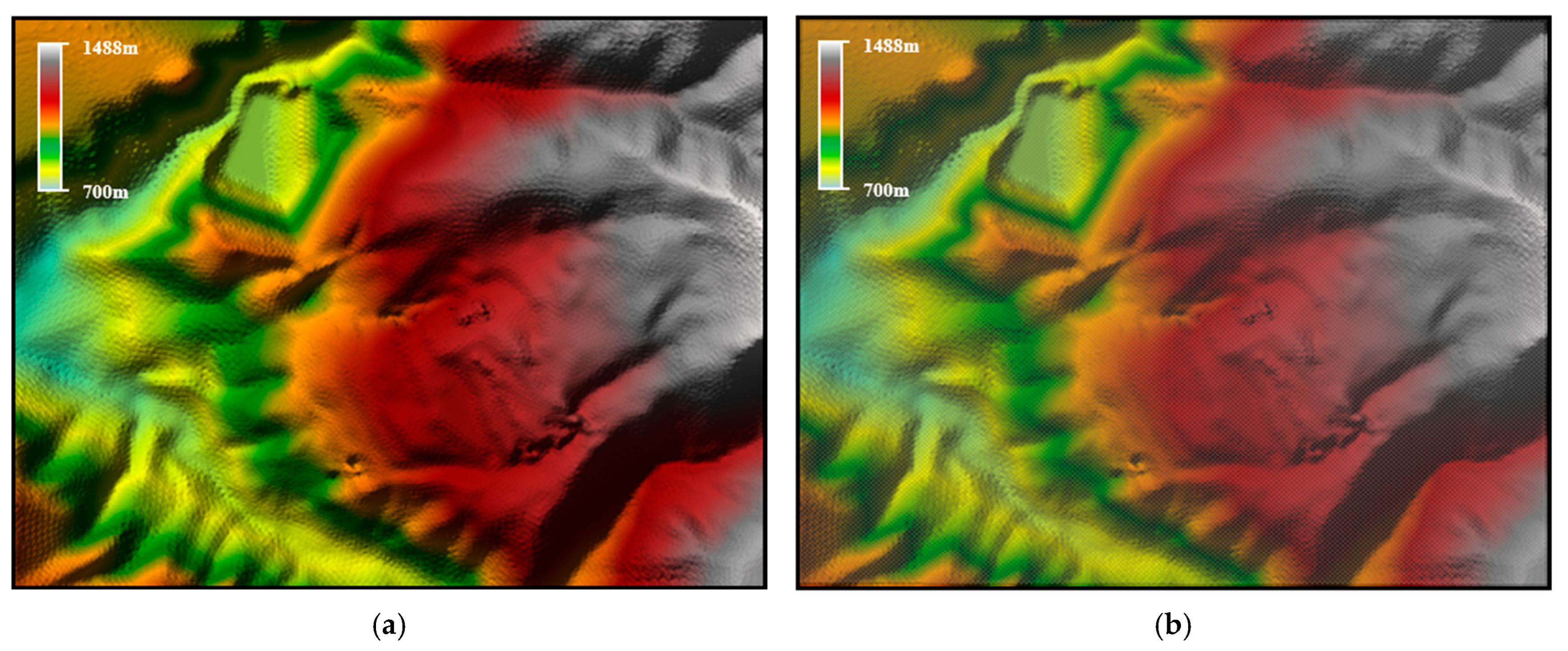


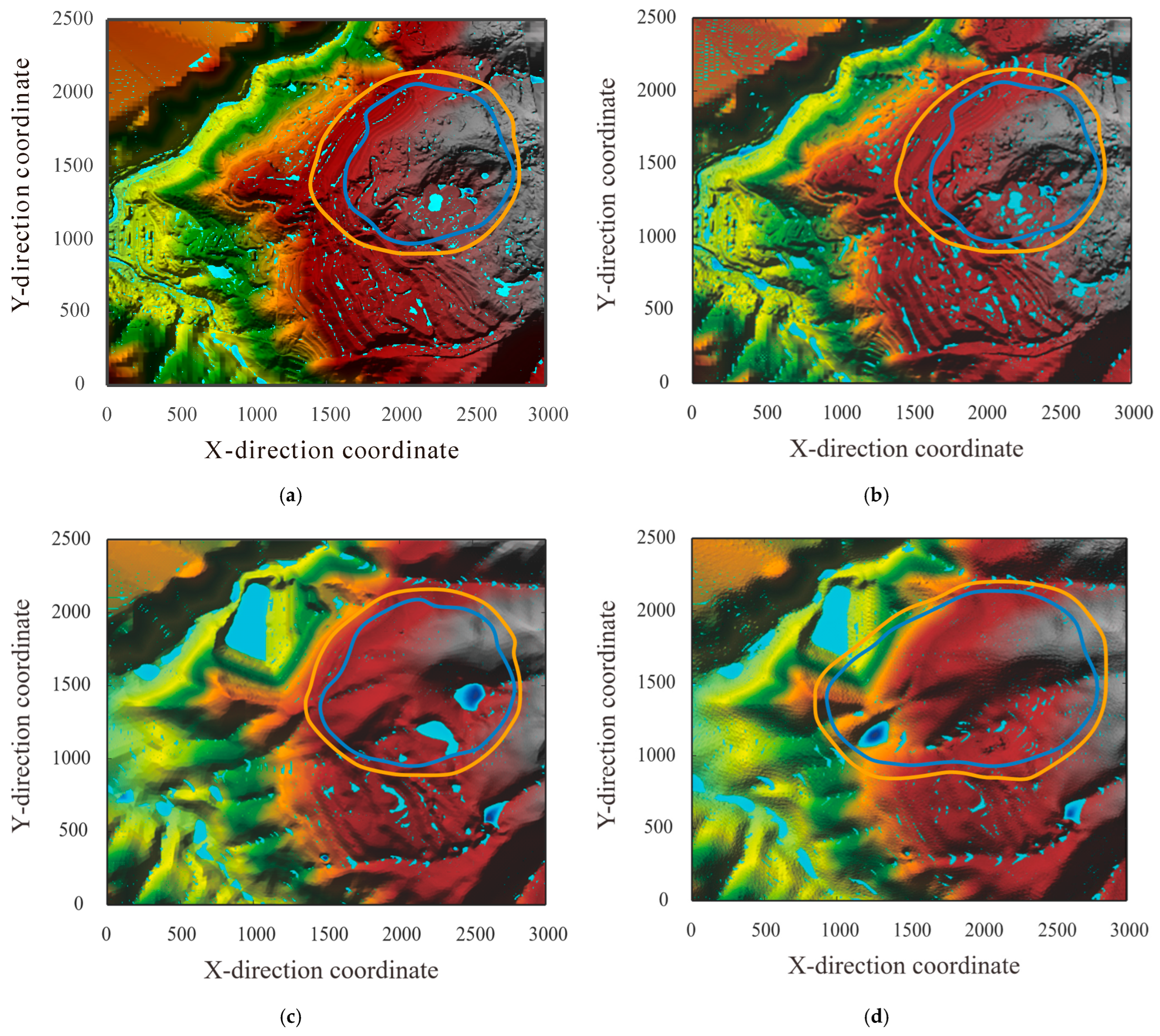
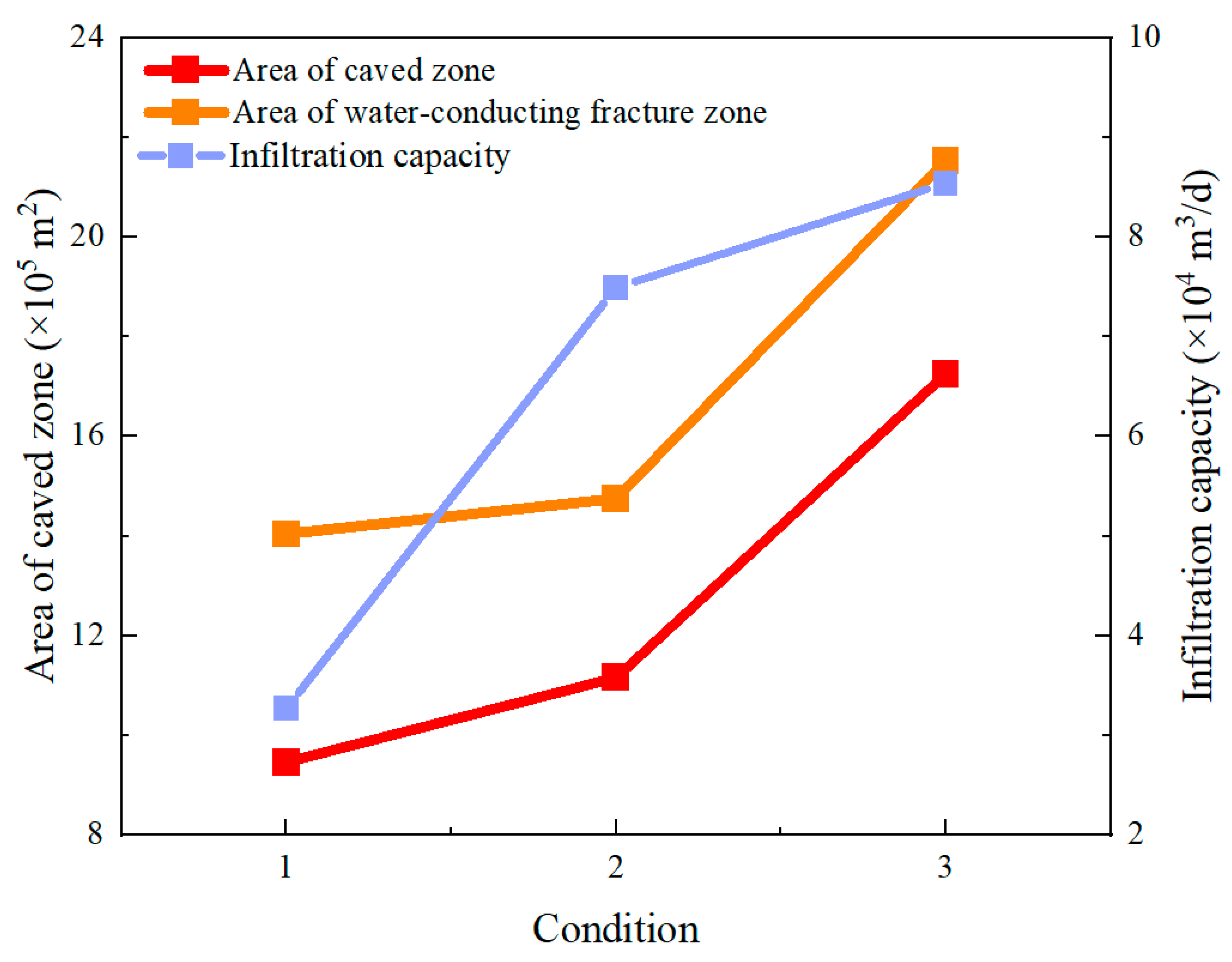
| Iithology | Natural Unit Weight (g/cm3) | Elastic Modulus (GPa) | Poisson’s Ratio | Tensile Strength (MPa) | Cohesion (MPa) | Friction Angle (°) |
|---|---|---|---|---|---|---|
| Falling objects | 2.10 | 12.30 | 0.17 | 0.50 | 0.50 | 38.0 |
| Material | 1.40 | 12.30 | 0.45 | 0.01 | 0.01 | 40.0 |
| Foundation | 1.81 | 0.60 | 0.33 | 0.10 | 0.20 | 43.2 |
| Dolomite albitite | 3.12 | 17.94 | 0.28 | 2.96 | 2.50 | 45.4 |
| Gabbro diabase | 2.80 | 16.42 | 0.31 | 2.75 | 2.75 | 46.8 |
| Sodium lava | 2.81 | 19.51 | 0.30 | 4.03 | 2.67 | 45.8 |
| Dolomite marble | 2.86 | 18.82 | 0.31 | 3.84 | 2.59 | 46.6 |
| Iron ore | 3.60 | 21.33 | 0.28 | 3.54 | 2.85 | 48.4 |
| Copper mine | 3.50 | 16.42 | 0.27 | 2.76 | 2.75 | 46.8 |
| Point | Actual Displacement Changes | Numerical Simulation Results | Error |
|---|---|---|---|
| G1 | −28.3 mm | −25.58 mm | −9.6% |
| G5 | −21.3 mm | −21.77 mm | 2.2% |
| G6 | −22.4 mm | −24.19 mm | 7.9% |
| G7s3 | −22.6 mm | −24.72 mm | 9.4% |
| G8s2 | −24.6 mm | −26.33 mm | 7.0% |
| G9 | −24.1 mm | −25.92 mm | 7.5% |
| G15s2 | −28.5 mm | −26.51 mm | −6.9% |
| G22 | −29.0 mm | −27.98 mm | 3.5% |
| Degree and Characteristics of Rock (Soil) Layer Damage on Collapsed Surfaces and Ore Body Roof | Characteristics of Overlying Soil on the Ore Body | Design-Frequency Rainstorm Infiltration Coefficient | |
|---|---|---|---|
| The collapse zone has not extended to the surface; only the water-conducting fracture zone has extended to the surface. | Nonplastic waterproof soil layer | Brittle rock | 0.20~0.15 |
| Plastic rock | 0.15~0.10 | ||
| Plastic waterproof soil layer Thickness (m) | 5~10 | 0.10~0.05 | |
| 11~20 | ≤0.05 | ||
| The overlying rock at the top of the ore body does not collapse repeatedly. | Nonplastic waterproof soil layer | Brittle rock | 0.35~0.30 |
| Plastic rock | 0.30~0.20 | ||
| Plastic waterproof soil layer Thickness (m) | 5~10 | 0.20~0.15 | |
| 11~20 | 0.15~0.10 | ||
| 21~30 | 0.10~0.05 | ||
| 31~50 | ≤0.05 | ||
| Repeated collapse of overlying rock at the top of the ore body | Nonplastic waterproof soil layer | Brittle rock | 0.40~0.30 |
| Plastic rock | 0.30~0.25 | ||
| Plastic waterproof soil layer Thickness (m) | 5~10 | 0.25~0.20 | |
| 11~20 | 0.20~0.15 | ||
| 21~30 | 0.15~0.10 | ||
| 31~50 | 0.10~0.05 | ||
| Ground Type | Runoff Coefficient Φ |
|---|---|
| Various roofs or concrete or asphalt pavements | 0.85~0.95 |
| Gravel pavement with large stone paving or asphalt surface treatment | 0.55~0.65 |
| Graded crushed stone pavement | 0.40~0.50 |
| Dry masonry or gravel pavement | 0.35~0.40 |
| Unpaved soil pavement | 0.25~0.35 |
| Park or green space | 0.10~0.20 |
| Region | Area (m3) | Water-Collecting Amount (m3/d) | Infiltration Coefficient | Runoff Coefficient | Infiltration Capacity (m3/d) | Water Discharge |
|---|---|---|---|---|---|---|
| Caved Zone | 946,181.043 | 9871.772 | 0.4 | - | 4820.5816 | 4590.806 |
| Water-Conducting Fracture Zone | 1,404,063.217 | 3020.809 | 0.3 | 0.3 |
| Region | Area (m3) | Water-Collecting Amount (m3/d) | Infiltration Coefficient | Runoff Coefficient | Infiltration Capacity (m3/d) | |
|---|---|---|---|---|---|---|
| Condition 1 | Caved Zone | 946,181.043 | 78,145.303 | 0.4 | - | 32,704.6594 |
| Water-Conducting Fracture Zone | 1,404,063.217 | 16,072.647 | 0.3 | 0.3 | ||
| Condition 2 | Caved Zone | 1,115,764.036 | 184,942.049 | 0.4 | - | 74,915.6012 |
| Water-Conducting Fracture Zone | 1,475,216.672 | 10,430.907 | 0.3 | 0.3 | ||
| Condition 3 | Caved Zone | 1,725,046.769 | 210,728.485 | 0.4 | - | 85,401.1802 |
| Water-Conducting Fracture Zone | 2,152,679.054 | 12,330.958 | 0.3 | 0.3 |
| Classification of Anti-Seepage Areas | Anti-Seepage Grade | Anti-Seepage Measure |
|---|---|---|
| Flooded zones encompassing both the caved zone and water-conducting fracture zone | Level 1 | Stratified fracture grouting Geomembrane installation Pumping drainage system |
| Non-flooded sections of the caved zone | Level 2 | Stratified fracture grouting |
| Non-inundated portions of the water-conducting fracture zone | Level 3 | Direct fracture grouting |
| Supplementary anti-seepage measures | Circular cutoff drainage system installed at the collapse area periphery | |
Disclaimer/Publisher’s Note: The statements, opinions and data contained in all publications are solely those of the individual author(s) and contributor(s) and not of MDPI and/or the editor(s). MDPI and/or the editor(s) disclaim responsibility for any injury to people or property resulting from any ideas, methods, instructions or products referred to in the content. |
© 2025 by the authors. Licensee MDPI, Basel, Switzerland. This article is an open access article distributed under the terms and conditions of the Creative Commons Attribution (CC BY) license (https://creativecommons.org/licenses/by/4.0/).
Share and Cite
Jiao, S.; Zhao, Y.; Yang, T.; Wen, X.; Ma, Q.; Zhao, Q.; Liu, H. Analysis of Surface Runoff and Ponding Infiltration Patterns Induced by Underground Block Caving Mining—A Case Study. Appl. Sci. 2025, 15, 9516. https://doi.org/10.3390/app15179516
Jiao S, Zhao Y, Yang T, Wen X, Ma Q, Zhao Q, Liu H. Analysis of Surface Runoff and Ponding Infiltration Patterns Induced by Underground Block Caving Mining—A Case Study. Applied Sciences. 2025; 15(17):9516. https://doi.org/10.3390/app15179516
Chicago/Turabian StyleJiao, Shihui, Yong Zhao, Tianhong Yang, Xin Wen, Qingshan Ma, Qianbai Zhao, and Honglei Liu. 2025. "Analysis of Surface Runoff and Ponding Infiltration Patterns Induced by Underground Block Caving Mining—A Case Study" Applied Sciences 15, no. 17: 9516. https://doi.org/10.3390/app15179516
APA StyleJiao, S., Zhao, Y., Yang, T., Wen, X., Ma, Q., Zhao, Q., & Liu, H. (2025). Analysis of Surface Runoff and Ponding Infiltration Patterns Induced by Underground Block Caving Mining—A Case Study. Applied Sciences, 15(17), 9516. https://doi.org/10.3390/app15179516






